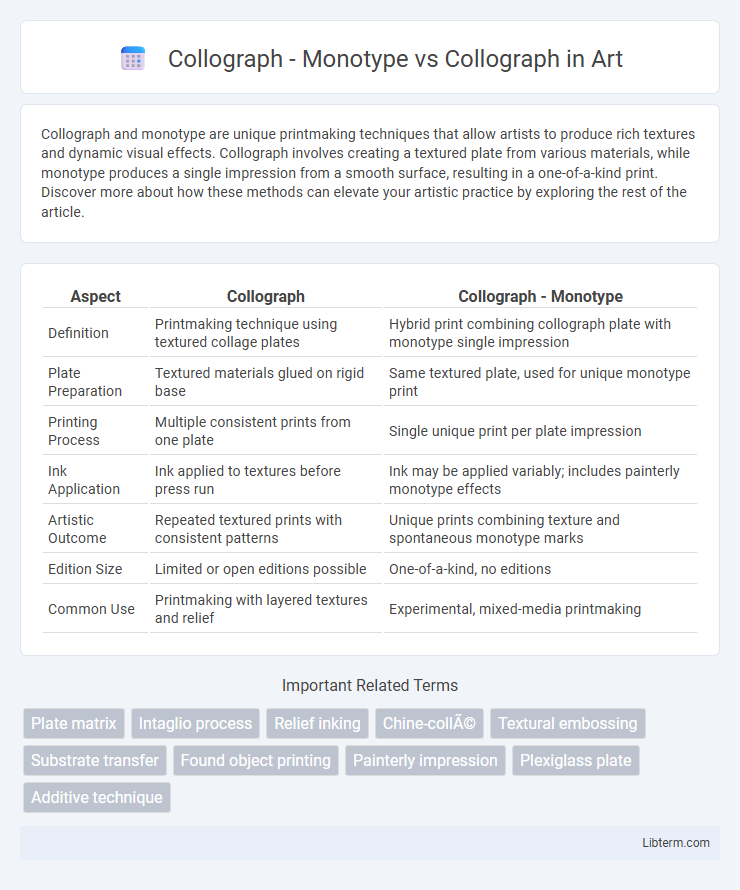Collograph and monotype are unique printmaking techniques that allow artists to produce rich textures and dynamic visual effects. Collograph involves creating a textured plate from various materials, while monotype produces a single impression from a smooth surface, resulting in a one-of-a-kind print. Discover more about how these methods can elevate your artistic practice by exploring the rest of the article.
Table of Comparison
| Aspect | Collograph | Collograph - Monotype |
|---|---|---|
| Definition | Printmaking technique using textured collage plates | Hybrid print combining collograph plate with monotype single impression |
| Plate Preparation | Textured materials glued on rigid base | Same textured plate, used for unique monotype print |
| Printing Process | Multiple consistent prints from one plate | Single unique print per plate impression |
| Ink Application | Ink applied to textures before press run | Ink may be applied variably; includes painterly monotype effects |
| Artistic Outcome | Repeated textured prints with consistent patterns | Unique prints combining texture and spontaneous monotype marks |
| Edition Size | Limited or open editions possible | One-of-a-kind, no editions |
| Common Use | Printmaking with layered textures and relief | Experimental, mixed-media printmaking |
Introduction to Collograph and Monotype Techniques
Collograph and Monotype printing techniques offer unique approaches to printmaking, with Collograph involving textured plates created through collage materials and Monotype producing singular prints from a smooth, inked surface. The Collograph process emphasizes relief and texture, allowing artists to build up intricate patterns using cardboard, fabric, and various substances, while Monotype focuses on painterly effects achieved by manipulating ink directly on a plate before transferring it to paper. Understanding these methods highlights their distinct artistic potentials: Collograph's tactile, repeatable impressions versus Monotype's spontaneous, one-of-a-kind images.
What is a Collograph Print?
A collograph print is a type of relief print made by applying textured materials to a rigid support surface, creating varied surfaces for inking and printing. Unlike monotype prints, which produce a single, unique impression using a smooth plate, collographs rely on the raised and recessed textures to produce multiple impressions with rich, tactile qualities. The use of diverse materials such as fabric, cardboard, or leaves allows for intricate patterns and depth not achievable in monotype printing.
Understanding Monotype Printing
Monotype printing transforms text and images into individual metal type or plates, enabling high precision and consistency in print. Collograph printing involves creating textured plates from various materials to produce rich, dimensional prints with tactile qualities. Understanding the detailed mechanical process of Monotype highlights its advantage in sharp, repeatable type reproduction compared to the expressive, variable textures of Collograph prints.
Key Differences Between Collograph and Monotype
Collograph is a printmaking technique involving textured plates created from various materials, offering a hands-on, artistic approach to image creation, while Monotype produces a single impression directly from a smooth, non-absorbent plate, emphasizing spontaneous and unique prints. Collograph allows for rich surface textures and multiple colors through layered collage elements, whereas Monotype focuses on painterly, fluid effects with a single, often unpredictable print outcome. The key difference lies in Collograph's use of relief textures and collage for repeated patterns, contrasting with Monotype's smooth plate and singular, one-of-a-kind impressions.
Materials Used in Collograph vs Monotype
Collograph prints utilize textured materials such as cardboard, fabric, and found objects to build raised collage plates that create varied surface impressions, while monotypes typically employ smooth metal or plexiglass plates for single, unique ink impressions. The collograph process emphasizes tactile, composite plates assembled from diverse materials, enhancing depth and texture distinct from the flat, painterly effects achieved in monotypes. These material differences significantly influence the visual qualities and tactile experience of the printed artwork.
Creative Processes: Collograph and Monotype Compared
Collograph printing involves building a textured plate from various materials to create intricate relief prints, emphasizing layered tactile detail and repeatable patterns. Monotype focuses on painting or drawing directly onto a smooth surface, producing unique, one-of-a-kind prints with spontaneous, fluid marks and unpredictable blending. Both techniques enhance artistic expression through distinct creative processes: collograph explores structure and texture, while monotype celebrates immediacy and singularity.
Visual Effects and Texture in Both Methods
Collograph monotype produces unique visual effects by combining the unpredictable ink transfer of monotype printing with the textured surfaces of a collograph plate, resulting in rich, layered textures and dynamic contrasts. In contrast, traditional collograph printing emphasizes the tactile quality and depth of embossed textures created by glued materials on the plate, offering more controlled and repeatable textural detail. Both methods highlight texture as a key visual element, with monotype variations fostering spontaneity and collograph allowing precise textural patterns.
Applications and Artistic Possibilities
Collograph monotypes offer unique textural effects by printing a single, unrepeatable image from a textured plate, ideal for experimental and expressive artworks. In contrast, traditional collographs allow artists to create multiple impressions from plates built with various materials, providing versatility in editioning and detailed layered textures. The artistic possibilities of monotypes revolve around spontaneity and painterly qualities, while collographs emphasize reproducibility and complex surface building for diverse printmaking techniques.
Tips for Choosing Between Collograph and Monotype
When choosing between Collograph and Monotype techniques, consider the desired texture and detail in your printmaking project; Collograph offers rich, tactile surfaces ideal for experimental and expressive works, while Monotype excels in producing unique, painterly prints with smooth gradients. Evaluate your project's complexity, as Collograph involves building plates with varied materials for layered effects, whereas Monotype requires quick, spontaneous mark-making on a smooth surface. Prioritize your workflow and artistic goals, selecting Collograph for depth and texture or Monotype for fluid, one-of-a-kind impressions.
Conclusion: Which Printmaking Technique Suits You?
Choosing between Collograph and Monotype depends on desired artistic effects and process preferences. Collograph offers textured, repeatable prints through collage-based plates, ideal for tactile and layered imagery, while Monotype produces unique, spontaneous prints with painterly qualities from a smooth plate. Artists seeking versatility and experimental texture benefit from Collograph; those valuing singular, expressive prints lean toward Monotype.
Collograph - Monotype Infographic

 libterm.com
libterm.com